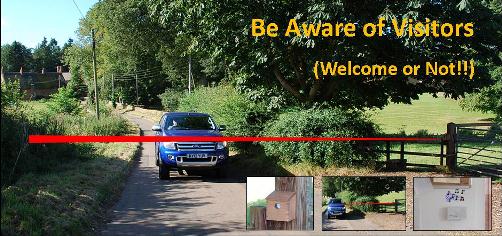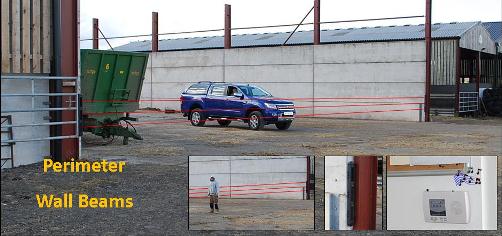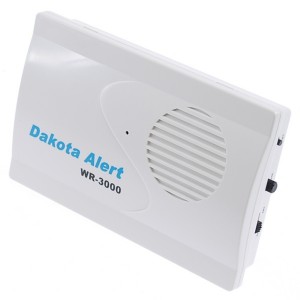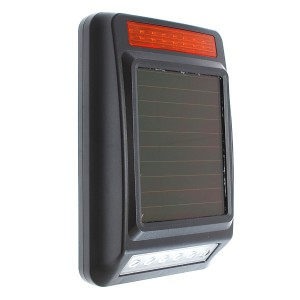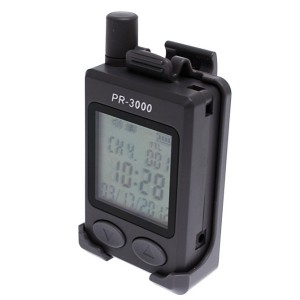We recommend that you ask yourself the following questions before choosing your Driveway Alarm
But before asking yourself these questions, we would recommend that you understand what a typical Driveway Alarm or Alert is !!
What is a Driveway Alarm or Alert?
A Driveway Alarm or Alert is designed to monitor Perimeter, Gateway or Entrance locations around your home or business premises, often locations that are out of sight, whilst also giving you extra security for the night. They will inform you by various methods to the presence of a Visitor (welcome or not), allowing you to be prepared in advance, and not being taken by surprise.
How Do They Work?
The majority of Driveway Alarms or Alerts are now using Wireless technology, making them very easy & quick to fit, therefore we will concentrate on these for this article. They consist of one or more battery powered Detectors which would be positioned near too vulnerable & blind locations that you need to monitor for visitors or intruders (more detailed information about the different types of detectors detailed below).
Once any off the chosen Detectors are triggered by a Visitor or Intruder, a wireless signal is transmitted back to one or more Receivers which will notify you in the chosen way to their presence. These Receivers would normally be located inside the house or office, but also available are External Sirens, Portable Pagers & Auto-Diallers, quite often one or more methods are deployed suiting different times of the day.
Detectors, Transmission & Receivers explained below !!
Detectors:
There are different types of Detectors that can be utilized, the two most common being the Passive Infra-Red (PIR) & Active Perimeter Beams.
PIR:
The typical PIR is powered by a standard battery (which will normally last up to a year) and are very easy & quick to install, they are constantly monitoring the immediate area within its designed detection range looking for a sudden increase of infra-red radiation which would be given off by most animals, people or vehicles. They do not have to be lined up with any other objects, there are no reflectors or other objects that need to be used.
The secret is to hide them away from the edge of the location that you want to monitor, well out of sight & out of mind (please take notice of the detection range & width within the specifications to ensure you choose a suitable model for your application).
The detection range is normally from 12 to 20 metres making it very easy to hide them away, the width (diameter) of the beam is also very important as in most applications you would want a narrow beam which could be mounted in a way to avoid detecting small ground animals such as Fox & Rabbits (popular narrow beam PIR’s are the long range Dakota or short range XL).
Typical installation would involve fitting the PIR at a height of 1 – 1.5 metres on:
- A wooden post 2 – 6 metres away from the edge of the monitored location.
- A wooden fence.
- Behind a gate post.
- Behind a fence panel, looking or protruding though a pre made hole.
- Inside a wooden bird box.
- Inside a plastic paint tub or water butt.
An example of fitting a popular Dakota Driveway Alarm PIR can be seen within this current article (click here), but the principle can relate to most other types of Driveway Alarms PIR’s.
Pictured below is a PIR in action, monitoring a rural Driveway.
Active Perimeter Beam:
An Active Beam is supplied in pairs, and are installed so that each Beam is actively looking & monitoring each other, as soon as this view is blocked a wireless signal would be transmitted back to the chosen Receiver. They would normally be thought off as far more accurate than a PIR, and less likely to give false alarms. Typically they can work at further distances apart than a PIR, up to 60 – 100 metres is not uncommon making them great for monitoring wider areas.
A video can be seen with this link explaining the basics of one type of Wireless Active Beam from Ultra Secure Direct.
Typical installation would involve fitting the Beams at a height of 1 – 1.5 metres on:
- Two wooden posts. if possible set well back from the edge of the monitored area, if the area being monitored is 50 metres wide, it makes sense to try to fit the beams at 60 – 70 (or more) metres apart.
- On two posts of brick pillars covering a building or yard.
Pictured below is a set of Beams in action, monitoring a farm compound.
Other types of Driveway Alarm Detectors could be:
- Vehicle sensing probes.
- Air Hoses.
- Gate Contacts.
If you would like details of these please contact Ultra Secure Direct for more information:
Transmission:
Wireless Transmission is a vital consideration when choosing which Wireless Driveway Alarm to purchase, as different manufacturers & models can vary considerably, it is basically how far the wireless signal from each Detector & Receiver can travel in the given locations. For further understanding of this principle please read the article within this link (click here)
Receivers:
Once you have chosen the correct Detectors, positioned them in the correct locations where they can effectively transmit a signal back to the Receivers, you need to ensure that the chosen Receiver or Receivers notify you to the presence of a visitor in a way suitable for you, the options are too numerous to list, but the most common are detailed below:
Plug In Chime Receiver:
The most common Receiver for Driveway Alarms, these are normally fitted inside your house or office, and when triggered will omit a simple chime, often with adjustable volume control, but some Receivers will also include:
- 12v outputs (used to trigger sirens, buzzers, flashing lights).
- Output relays (often used to activate timer relays, speech alerts, auto-diallers).
Shown below is a Receiver from the popular Dakota Driveway Alarms, this Receiver has all of the features listed above.
Outdoor Sirens:
Outdoor Siren are popular for two main reasons:
- To ensure that the visitor knows they have been detected, comforting for genuine visitors & uncomfortable for potential Intruders (who will hopefully turn around and go back where they came from).
- For when home & business owners are working away from the Receiver located inside the house (perhaps around a farm, kennel, warehouse or yard).
Some Sirens can be activated by using a receiver inside the house, some can work as a stand alone receiver working in conjunction with the chosen detectors.
Shown below is a Solar Powered Siren with built in Flashing Strobes from Ultra Secure Direct, which can be used as a very loud Alert or Siren working in conjunction with the Solar Powered Active Perimeter Beams.
Portable Pagers:
Portable Pagers are not so common with Driveway Alarms, but are available from some manufacturers, the most obvious one is the Dakota 2500E & 3000E which works with all of the popular Dakota Driveway Alarms and have a host of features including:
- 4 – channels.
- Unlimited number of detectors that can be used.
- Date & time stamped.
- Log event records.
- Audible alert.
- Vibration alert.
- Visual alert.
Shown below is the Dakota Pager which is ideal for when you are moving around your grounds or business, and can be used with Dakota Driveway Alarms.
Telephone Auto-Diallers:
Another popular addition to a Driveway Alarm is a Telephone Auto-Diallers, these normally connect to an internal Wireless Receiver and when armed will contact key-holders by either pre-recorded messages by telephone or text message when activated, ideal for times when you are away from the Receiver, perhaps simply working in a field or away on holiday. When you are inside the property you simply rely on the Chime Receiver and keep the Dialler turned OFF.
You can choose two different types of Diallers:
- Land line: these plug into your existing telephone line inside the house, and cost very little to operate (just the cost of a call).
- GSM: these utilize mobile phone technology and SIM cards (either Pay as you Go or Contract), these are ideal for locations with no easy access to a telephone line.
Our simple advice would normally be to use a land line dialler if you have access to a phone line (this will work out cheaper to run), although there are exceptions to this rule, for advice please contact Ultra Secure Direct.
Shown below is a Land-line Auto-Dialler:
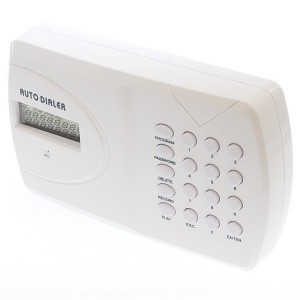
Telephone Auto-Dialer, will notify key-holders by pre-recorded messages via telephone or text messages, depending on the chosen model.
Questions to ask yourself:
- Where are you needing to Monitor?
- How many locations do you need to Monitor?
- How wide is each location that you need to Monitor?
- How far away from the proposed monitored location would the Receiver location be?
- How many & what type of obstructions are there between the proposed Monitored & Receiver locations?
- Have you got a power supply at the proposed location of the Receiver?
- Have you got a telephone line at the proposed location of the Receiver?
- Are the proposed Monitored locations prone to large Animals (deer, sheep, horses, cattle etc)?
- How do you want to be notified to the presence of a Visitor or Intruder?
Answering these questions will help you decide on & choose the most suitable Driveway Alarm !!
Typical Applications Driveway Alarms Are Used In:
- Domestic Homes with Driveways.
- Farms.
- Rural Shops.
- Business Grounds & Yards.
- Building Sites.
- HGV Vehicle Compounds.
- Fuel Tanks.
- Fisheries.
These are just a few of the examples where these Driveway Alarms are now being used, the list is endless !!
Summary:
A Driveway Alarm will give you early notification or warning to the presence of a visitor (friend or foe) , no more unpleasant surprises during the day or night, Ultra Secure Direct have probably the largest selections of these products within the UK and are happy to give Friendly, No Obligation Advice at any time, contact us here. Once you get used to owning a Driveway Alarm, you will not know how you managed before !!.
By Mark Walter Google

